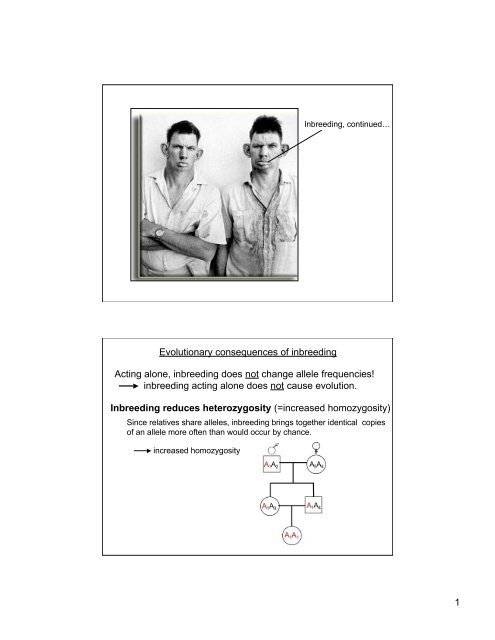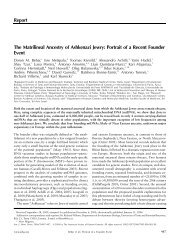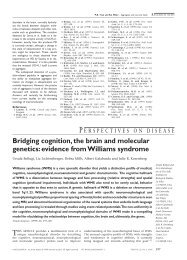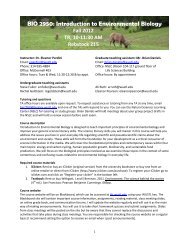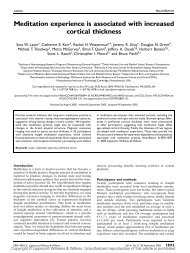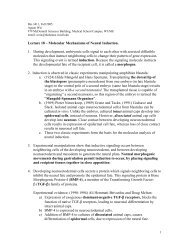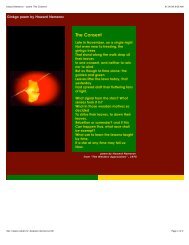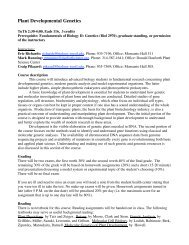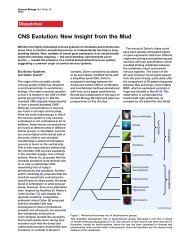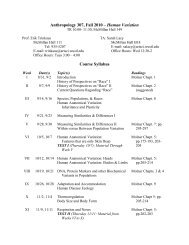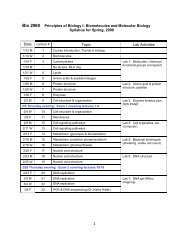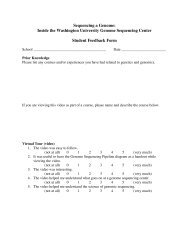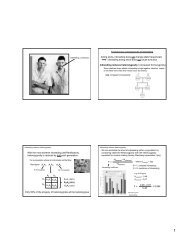increased homozygosity
increased homozygosity
increased homozygosity
Create successful ePaper yourself
Turn your PDF publications into a flip-book with our unique Google optimized e-Paper software.
Inbreeding, continued…<br />
Evolutionary consequences of inbreeding<br />
Acting alone, inbreeding does not change allele frequencies!<br />
inbreeding acting alone does not cause evolution.<br />
Inbreeding reduces heterozygosity (=<strong>increased</strong> <strong>homozygosity</strong>)<br />
Since relatives share alleles, inbreeding brings together identical copies<br />
of an allele more often than would occur by chance.<br />
<strong>increased</strong> <strong>homozygosity</strong><br />
1
Inbreeding reduces heterozygosity…<br />
With the most extreme inbreeding (self-fertilization),<br />
heterozygosity is reduced by half each generation:<br />
For a population where all individuals self-fertilize:<br />
Genotypes:<br />
A 1 A 1 A 1 A 2 A 2 A 2<br />
All homozygotes<br />
All homozygotes<br />
A 1<br />
A 1 A 2<br />
A 2<br />
A 1 A 1 A 1 A 2<br />
A 1 A 2 A 2 A 2<br />
A 1 A 1 (25%)<br />
A 1 A 2 (50%)<br />
A 2 A 2 (25%)<br />
Only 50% of the progeny of heterozygotes will be heterozygous<br />
Inbreeding reduces heterozygosity…<br />
We can estimate the level of inbreeding within a population by<br />
comparing observed heterozygosity with the heterozygosity<br />
expected for random mating (Hardy-Weinberg expectation: 2pq).<br />
F =<br />
Inbreeding coefficient<br />
H expected - H observed<br />
H expected<br />
where H expected = 2pq<br />
(F= 1: complete inbreeding)<br />
(F< 0: avoidance of inbreeding)<br />
2
Inbreeding reduces heterozygosity…<br />
We can estimate the level of inbreeding within a population by<br />
comparing observed heterozygosity with the heterozygosity<br />
expected for random mating (Hardy-Weinberg expectation: 2pq).<br />
F =<br />
Inbreeding coefficient<br />
H expected - H observed<br />
H expected<br />
where H expected = 2pq<br />
(F= 1: complete inbreeding)<br />
(F< 0: avoidance of inbreeding)<br />
e.g, for B gene:<br />
H expected = 0.48<br />
H observed = 0.07<br />
F =<br />
0.48 - 0.07<br />
0.48<br />
= 0.854<br />
Futuyma Fig. 9.6<br />
Avena fatua<br />
Inbreeding and fitness<br />
Inbreeding depression: reduced fitness due to inbreeding<br />
— ***expression of deleterious recessive alleles (e.g., disease)<br />
— loss of any fitness arising from heterozygote advantage<br />
(Italy, early 20th Century)<br />
Inbreeding can exacerbate expression of disease in populations that<br />
have gone through bottlenecks or founder events.<br />
3
Inbreeding depression may be most evident during times of stress<br />
Survivorship<br />
through the<br />
1989 blizzard<br />
‘Genetic rescue’ from inbreeding depression<br />
e.g., Isolated Swedish adder population (N
Mechanisms that prevent inbreeding in plants<br />
— Self-incompatibility (S-locus alleles can’t be shared)<br />
— Dioecy (male and female flowers on different plants)<br />
— Asynchronous flowering of male and female flowers on a plant<br />
— Heterostyly: 2 or morphological arrangements of stamens and stigmas;<br />
only plants with different arrangements will cross-pollinate<br />
Dioecious species:<br />
(Holly: Ilex sp.)<br />
Mechanisms that prevent inbreeding in animals: behavior<br />
— Dispersal of juveniles<br />
— Recognition of relatives and avoidance of mating with them<br />
e.g., mice avoid mating with individuals with shared alleles<br />
of the major histocompatibility (MHC) locus<br />
5
Not all populations avoid inbreeding<br />
e.g., Fig wasps: siblings mate with each other after hatching<br />
Fig wasp<br />
Not all populations avoid inbreeding<br />
Many plant species are partially or entirely self-fertilizing<br />
Arabidopsis thaliana<br />
(model genetic system)<br />
Rice (Oryza sativa)<br />
and many other crops<br />
Why self-fertilize<br />
Advantages:<br />
1) ***Reproductive assurance (e.g., N=1 founds new population)<br />
2) Low resource investment in attracting mates/pollinators<br />
3) Preserve ‘coadapted gene complexes’: optimal combination<br />
of alleles at different loci in an individual<br />
Nonetheless, self-fertilizing species may be evolutionary ‘dead ends’<br />
Severe inbreeding in a normally outcrossing species<br />
usually leads to population extinction.<br />
e.g., Sewall Wright: 35 guinea pig lines<br />
started from brother-sister matings.<br />
Within 9 years, half went extinct<br />
W = ~0.3 relative to control lines<br />
e.g., Inbred house mice lines<br />
Only 1 line out of 20 persisted to 12<br />
generations<br />
7
An unusual case…<br />
Inbreeding can potentially purge deleterious recessive<br />
alleles from a population (none hiding in heterozygotes)<br />
e.g, Chillingham wild cattle (N300 years of total inbreeding<br />
Complete <strong>homozygosity</strong> at<br />
24 of 25 loci examined<br />
(Other cattle:>70%<br />
heterozygous at the same<br />
loci)<br />
No drop in viability or<br />
fecundity relative to other<br />
cattle.<br />
Sexual Selection<br />
• Viability: probability of survival to reproductive age<br />
• Mating Success<br />
Sexual selection: differential reproductive success<br />
due to differential mating success<br />
• Fecundity: viable offspring<br />
Bright coloration: favored for mating<br />
success — attracts females<br />
Dull coloration: favored for protection from<br />
predators<br />
Guppy (Poecilia sp.)<br />
8
Why is there competition for mates<br />
Sexes differ in energetic costs of reproduction:<br />
-sperm are cheap, eggs are limited<br />
-parenting investment (usually more by mother)<br />
Why is there competition for mates<br />
Two consequences:<br />
Sexes differ in energetic costs of reproduction:<br />
-sperm are cheap, eggs are limited<br />
-parenting investment (usually more by mother)<br />
1) Reproduction is energetically limited for female: she should be choosy<br />
2) Fewer receptive females than males: females are limited resource,<br />
so males will vary in their mating success<br />
Males will compete for females<br />
Exception: if male’s parenting investment exceeds female’s:<br />
female<br />
male<br />
Phalarope (Phalaropus fulicarius)<br />
9
Intrasexual selection: competition between males<br />
1. Direct competition for mates<br />
Male-male competition during copulation<br />
10
Evolutionary consequences of direct competition for mates<br />
Selection for larger size, traits that facilitate fighting success<br />
- leads to dimorphism between sexes<br />
Fitness and male body size: viability vs. mating success<br />
Male marine iguanas are larger than the optimal size for survival,<br />
given available food resources (algae).<br />
11
Intrasexual selection…<br />
Alternative male mating strategy: sneaky males<br />
e.g., many fish species<br />
e.g., dimorphism in male Rhinocerous beetles:<br />
Males that battle for and guard females<br />
vs.<br />
Small males that sneak into females’ tunnels<br />
Disruptive sexual selection on male morphology<br />
Three male mating strategies in lizard:<br />
a) ‘Ultradominant’: territory with multiple females<br />
b) Small, carefully guarded territory: 1 female<br />
c) No territory, sneak in on ultradominants<br />
negative frequency-dependent selection<br />
Side-blotched lizard<br />
Forms of intrasexual selection…<br />
2. Sperm competition:<br />
• Remove competitors’ sperm<br />
• Plug female genitalia following mating<br />
• Produce more sperm (larger testes)<br />
• Repeated matings<br />
Polygamous primates produce<br />
more sperm<br />
Damselfly penis has horn<br />
that removes other males’<br />
sperm<br />
Futuyma, Fig. 14.7<br />
12
Forms of intrasexual selection…<br />
3. Infanticide:<br />
Accounts for 25% of all lion cub deaths in first year of life<br />
10% of lion mortality overall<br />
Puma cub<br />
13
Intersexual selection: mate choice<br />
Females often mate preferentially with showy males<br />
Enlarged, ornamented traits; coloration; vocalization; other<br />
behavior.<br />
Showy male<br />
Drab female<br />
Like intrasexual selection, leads to evolution of sexual dimorphism<br />
Mate choice: female widowbirds prefer longer-tailed males<br />
Futuyma, Fig. 11.9<br />
14
Intersexual selection: mate choice<br />
Leads to trait divergence<br />
among closely related<br />
species.<br />
Traits favored by mate choice my compromise a male’s viability<br />
e.g., guppy coloration with predators<br />
e.g., Vocalizations in túngara frogs:<br />
Physalaemus pustulosis<br />
15
Mate choice: How and why do female preferences arise<br />
Explanation 1: Direct benefits. Females choose traits with<br />
direct benefits for her or her offspring.<br />
e.g., Female birds pick males with best territory, resources.<br />
Mate choice: How and why do female preferences arise<br />
Explanation 1: Direct benefits. Females choose traits with<br />
direct benefits for her or her offspring.<br />
e.g., Female birds pick males with best territory, resources.<br />
e.g., Female hangingflies prefer males who provide larger prey during<br />
mating.<br />
16
Explanation 2: Sensory bias. Intrinsic preference for particular<br />
sensory stimuli. Female’s preference precedes the evolution of the<br />
preferred male trait.<br />
e.g., Prey orientation: lizard movement<br />
Explanation 2: Sensory bias. Intrinsic preference for particular<br />
sensory stimuli. Female’s preference precedes the evolution of the<br />
preferred male trait.<br />
e.g., Prey orientation: lizard movement<br />
e.g., Females of fish species 1 prefer long tails even though no males<br />
possess them: preference predates the species.<br />
Species 1<br />
Species 2<br />
P+: females prefer long tails<br />
T+: males possess long tails<br />
Female preference for long tails<br />
arose before Species 1 and 2<br />
diverged from their common ancestor<br />
17
Sensory bias and female preference…<br />
Zebra finches females prefer males with an artificial white crest<br />
Explanation 3: Indirect benefits. Females prefer males with traits that<br />
indirectly benefit the female or her offspring.<br />
a) “Sexy son” hypothesis (= Runaway sexual selection)<br />
(=“Fisherian model”)<br />
Sons inherit trait that made father attractive to mother (mating success);<br />
favored by future generations of females<br />
These successful<br />
males will pass on the<br />
alleles for the trait<br />
(expressed in their<br />
sons) and the alleles<br />
for the trait preference<br />
(expressed in their<br />
daughters).<br />
18
Explanation 3: Indirect benefits. Females prefer males with traits that<br />
indirectly benefit the female or her offspring.<br />
a) “Sexy son” hypothesis (= Runaway sexual selection)<br />
(=“Fisherian model”)<br />
Sons inherit trait that made father attractive to mother (mating success);<br />
favored by future generations of females<br />
These successful<br />
males will pass on the<br />
alleles for the trait<br />
(expressed in their<br />
sons) and the alleles<br />
for the trait preference<br />
(expressed in their<br />
daughters).<br />
Establishes<br />
genetic correlation<br />
between the trait<br />
(T) and preference<br />
for the trait (P):<br />
Offspring of T 2<br />
males and P 2<br />
females will carry<br />
both T 2 and P 2<br />
alleles.<br />
(Both sexes carry both genes, but each is only expressed in one sex.)<br />
Sexy son hypothesis illustrated: sandfly<br />
Offspring of most vs<br />
least attractive males do<br />
not differ in viability or<br />
fecundity (=no direct<br />
benefits).<br />
Lutzomyia<br />
longipalpis<br />
But sons of attractive<br />
fathers have greatest<br />
mating success.<br />
19


